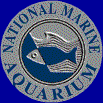
The National Marine Aquarium
and Records of Marine Life
Since the NMA was founded, and certainly before the Aquarium opened, it has been recognised locally as a centre for marine knowledge and people have been contacting us about all matters fishy.
Throughout this year we have been regularly receiving telephone reports of strange fish, fish in unusual places and other interesting marine life. Our receptionists are getting quite accustomed to fishermen from the market next door or the general public turning up with something in the bottom of a bucket, or a rather limp looking plastic bag and now even jellyfish through the post. Sometimes these are interesting animals for the aquarium, but the dead specimens all help us to learn more about our marine life. The NMA encourages all reports of unusual fish and other marine life, and also wants records of sightings or strandings of turtles, whales, dolphins, sharks, fish (e.g. Sunfish) and even jellyfish. While we have in our first year primarily been dealing with Devon and Cornwall, we will now be making an effort to extend this to a national coverage.
Most of our information comes from fishermen who spend their working lives at sea, but we also received lots of useful data from anglers, sailors, yachtsmen, divers, birdwatchers, coastguards and the general public. It is helpful if the reports contain as much information as possible - date, species or description of the animal, number size and behaviour of the animals, other creatures around, depth, type of shore or seabed, name of the boat, name and telephone number of the observer. All are useful, any information is better than none.
Even vague reports can prove useful, as they stimulate further investigation. We had a ‘phone call this summer from a yachtsman who thought he might have seen a Flying Fish in mid Channel, then a visitor to the Aquarium reported one glimpsed a few months ago – close to the previous sighting and 3 weeks before it. Did anyone else see Flying Fish in the Channel (or elsewhere) this summer?
In all we have received over 150 reports, covering 42 species of fish from British waters and a further 4 from the Bay of Biscay, as well as 3 or 4 types of whale or dolphin and 10 other animals. These have included the first English Short-snouted Seahorse, the first Small-scaled Scorpionfish in Britain from over sixty years, the first Silver Pomfret from inshore waters, 2 ‘Golden’ Haddock and a 3.2 kg (7 lb) Octopus. We even had the first Chinese Mitten Crab (an invading alien) for the south coast. (which is at present in our quarantine facility.) Did you realise there have been 6 Leatherback and 1 Loggerhead Turtles around Cornwall this summer as well as hundreds of Basking Sharks?
Great, but what did we do with all this data? The NMA acts as a collecting centre for information. We do not run our own database, but all the information received is passed on to the relevant county Biological Records Centres and to the Marine Biological Association of the U.K., which acts as custodian for the records, as well as Seaquest and other national marine databases. All these systems will soon be linked over the Internet by Marine Life Information Network (British Isles) (MarLIN) into a national Marine Fauna Database. It is envisage that the NMA will become a major source of input into MarLIN, so that every single report we receive will become part of the national picture. As a highly visible organisation with over 400,000 visitors each year, the NMA is ideally suited to take on the role of the public face of marine science in Britain directing material in to the scientific community and passing information out to the general public. Occasionally for conservation or other reasons records will have to be kept confidential, but this will be exceptional.
Why do we bother? Well, we find it exciting that a 340 kg (750 lb) Bluefin Tuna was caught close to Plymouth and hope that others are fascinated as well. However the real reason is that there is still much to be learnt about British marine life. We need more information so that we have an impartial factual basis to tell when changes occur and provide a sound background for further investigations. These may be able to demonstrate the effects of fishing, pollution or global warming.
We are also becoming involved in specific studies in co-operation with the Environment Agency. One of these is a study of Shad distribution, biology and evidence for breeding. Another is a publicity campaign to find the extent of Mitten Crabs on the South Coast and monitor any spread.
We are totally reliant on our informants who are adding so much to our knowledge of the sea. So next time you come across something that might be unusual, please get in touch with Doug Herdson, the Information Officer at the National Marine Aquarium, (Tel: 01752 600301), who will be interested to hear from you. We do have report forms available on request and reports can be faxed through to Doug (Tel: 01752 275205) or sent by e-mail : education@national-aquarium.co.uk.
National Marine Aquarium at Plymouth Web Site
Douglas Herdson, 11.1.1999
National Marine Aquarium Selected Fish Records
Please also send the records to the British Marine Life Study Society
Message hosted by the
British
Marine Life Study Society